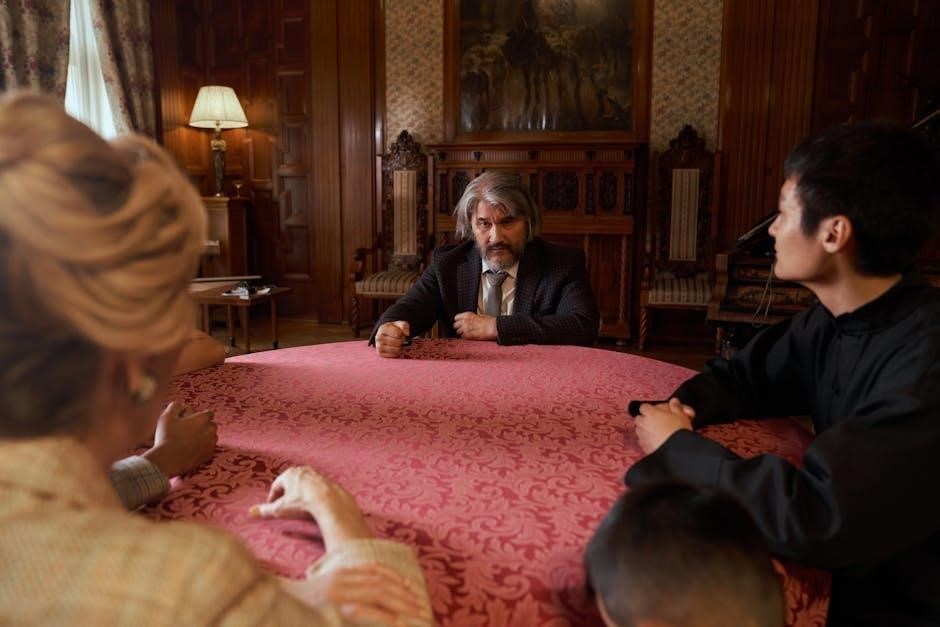The Council of Trent, spanning 1545–1563, was a pivotal Catholic response to the Protestant Reformation, aiming to clarify doctrine and reform Church practices, shaping Catholic identity.
1.1 Historical Context and Purpose
The Council of Trent convened in 1545 amidst the Protestant Reformation, aiming to address theological disputes and reform the Catholic Church. Initiated by Pope Paul III, it sought to clarify Catholic doctrine, counter Protestant challenger, and restore Church unity. The council addressed key issues like Scripture, sacraments, and Church practices, ultimately reaffirming traditional Catholic teachings. Its decrees and canons provided a theological foundation for the Counter-Reformation, shaping Catholic identity for centuries.
1.2 Key Objectives and Outcomes
The Council of Trent’s primary objectives were to counter Protestant doctrines, clarify Catholic teachings, and implement ecclesiastical reforms. Key outcomes included reaffirming the authority of Scripture and Tradition, defining the sacraments, and establishing strict Counter-Reformation policies. The council also produced detailed canons and decrees, which remain foundational for Catholic theology and practice, ensuring the Church’s doctrinal integrity and unity in response to the challenges of the Reformation era;

The Canons and Decrees of the Council of Trent
The Council of Trent produced definitive canons and decrees, outlining Catholic doctrine and disciplinary reforms, which remain foundational for understanding Catholic theology and practice to this day.
2.1 Decrees on the Canonical Scriptures
The Council of Trent affirmed the authority of Sacred Scripture and Tradition as equal sources of divine revelation. It decreed the inclusion of the Deuterocanonical books in the biblical canon, rejecting Protestant views that excluded them. The council also emphasized the Latin Vulgate as the authoritative text for Church teachings. These decrees were pivotal in defining Catholic doctrine on Scripture, ensuring its interpretation remained under Church authority and countering Protestant sola scriptura principles. This reaffirmed the Church’s role as the interpreter of divine revelation.
2.2 Canons on Sacraments and Worship
The Council of Trent issued decrees reaffirming the sacraments as divine institutions and means of grace. It emphasized the real presence of Christ in the Eucharist, defended the sacrificial nature of the Mass, and upheld the veneration of saints and sacred images. The council also addressed liturgical practices, ensuring they aligned with Catholic doctrine. These canons countered Protestant criticisms, reaffirming the necessity of sacraments for salvation and the Church’s role in mediating grace. The decrees also clarified the number and nature of the seven sacraments, solidifying Catholic worship traditions.

Notable Sessions of the Council
The Council of Trent held multiple significant sessions, each addressing key theological and disciplinary issues, shaping Catholic doctrine and reform efforts throughout its 18-year duration.
3.1 The First Session: Initial Gathering and Agenda
The First Session of the Council of Trent commenced in 1545, convened by Pope Paul III. It established the council’s authority, affirmed Catholic doctrine, and set the agenda to address Protestant challenges and internal Church reforms. This session laid the foundation for subsequent discussions, emphasizing the Church’s commitment to countering heresy and promoting unity. Its deliberations marked the beginning of a structured response to the theological and disciplinary issues plaguing the Church during the Reformation era.
3.2 The Fourteenth Session: Doctrine on the Eucharist
The Fourteenth Session of the Council of Trent, held in 1551, focused on reaffirming Catholic doctrine on the Eucharist. It declared the Real Presence of Christ in the sacrament, emphasizing transubstantiation, and upheld the sacrificial nature of the Mass. The session rejected Protestant interpretations, asserting the Church’s authority in sacramental theology. This session’s decrees became foundational for Catholic Eucharistic doctrine, countering Reformation critiques and reinforcing traditional teachings. Its canons remain pivotal in Catholic liturgical and theological understanding.

3.3 The Twenty-Second Session: Doctrine on Justification
The Twenty-Second Session, held in 1562, addressed the doctrine of justification, countering Protestant views. It reaffirmed that justification involves faith and works, not faith alone, emphasizing the role of sacraments and grace. The session’s decrees rejected the Protestant concept of justification as a legal declaration, instead highlighting the transformative power of grace. This session’s canons remain central to Catholic soteriology, clarifying the Church’s stance on salvation. The decrees are documented in PDF formats, such as those translated by H.J. Schroeder, providing accessible historical records of this pivotal doctrine.
Impact and Legacy of the Council
The Council of Trent’s reforms and decrees revitalized the Catholic Church, countering the Protestant Reformation. Its legacy endures in Catholic doctrine and practices, with PDF documents preserving its history.
4.1 Response to the Protestant Reformation
The Council of Trent was a direct response to the Protestant Reformation, addressing theological disputes and reforming Catholic practices. It reaffirmed traditional doctrines, such as the authority of Scripture and Tradition, the sacraments, and clerical celibacy, while condemning Protestant views. The Council’s decrees, documented in PDF formats, emphasized the Church’s teachings, solidifying its stance against Protestantism and shaping Catholic identity for centuries. These decisions influenced the Counter-Reformation, reinforcing Catholic doctrine and practices, and remain pivotal in understanding the Church’s historical response to religious challenges.
4.2 Reforms and Clarifications in Catholic Doctrine
The Council of Trent introduced significant reforms and clarifications in Catholic doctrine, addressing issues like indulgences, clerical abuses, and theological ambiguities. It reaffirmed the importance of sacraments, the doctrine of justification, and the authority of Scripture alongside Tradition. The Council also established clearer guidelines for Church practices, such as episcopal residency and the education of clergy, aiming to restore discipline and purity within the Church. These reforms, documented in PDF records, strengthened Catholic doctrine and provided a theological foundation for the Counter-Reformation, ensuring the Church’s teachings remained coherent and authoritative.

Availability of Council of Trent Documents in PDF Format
The Council of Trent’s documents, including translations by J. Waterworth and H.J. Schroeder, are widely available in PDF format online, accessible through historical archives and scholarly platforms.
5.1 Translations and Editions by J. Waterworth and H.J. Schroeder
The Council of Trent’s documents are available in English through notable translations by J. Waterworth (1848) and H.J. Schroeder (1941). Waterworth’s translation, published in London, includes the canons and decrees, while Schroeder’s edition provides a comprehensive overview of the Council’s history and significance. These translations are widely accessible in PDF format, offering insights into the Council’s doctrines and reforms. Both editions are invaluable resources for scholars and enthusiasts, preserving the legacy of Trent’s foundational decrees and canons.
5.2 Online Resources and Digital Archives
Digital archives and online resources provide easy access to the Council of Trent’s documents. Websites like Google Books, Internet Archive, and HathiTrust offer PDF versions of Waterworth’s and Schroeder’s translations. These platforms host comprehensive collections, including session transcripts, decrees, and historical analyses. Users can download or read these materials freely, facilitating research and study of the Council’s significance. Digital accessibility ensures these foundational texts remain widely available for scholars and enthusiasts alike, preserving their historical and theological importance.
Theological Significance of the Council’s Decrees
The Council of Trent’s decrees redefined Catholic theology, emphasizing Scripture and Tradition, sacraments, and justification, countering Protestant views and shaping Catholic doctrine for centuries.
6.1 Doctrine on the Holy Scripture and Tradition
The Council of Trent affirmed the equal authority of Holy Scripture and Tradition, rejecting the Protestant principle of sola scriptura. It declared that both sources are essential for divine revelation, maintaining the Church’s role in interpreting Scripture. This decree underscored the importance of Tradition in understanding sacred texts, ensuring continuity with apostolic teachings. The Council’s stance clarified Catholic orthodoxy, distinguishing it from emerging Protestant perspectives and reinforcing the Magisterium’s authority in theological matters.
6.2 Veneration of Relics and Sacred Images
The Council of Trent reaffirmed the veneration of relics and sacred images, emphasizing their role in fostering devotion and instructing the faithful. It distinguished this practice from idolatry, asserting that honor paid to images and relics is directed toward the saints they represent, not the objects themselves. This decree upheld the Catholic tradition of using visual and tangible aids to deepen spiritual connection, ensuring continuity in worship practices while countering Protestant critiques of such devotions.
The Council of Trent played a pivotal role in shaping Catholic doctrine and practice, providing a robust response to the Protestant Reformation. Its decrees and canons clarified key tenets of faith, such as the authority of Scripture and Tradition, and reaffirmed the importance of sacraments and sacred images. The council’s reforms strengthened the Church’s institutional structure and spiritual life, leaving a lasting legacy that influenced Catholic identity for centuries. Its decisions remain foundational, guiding the Church through subsequent challenges and theological developments.




